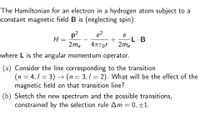Question
TRQ9. Solve completely the following Quantum
problem. Need full detailed answer, equations and if
possible, theory/literature.

Transcribed Image Text:The Hamiltonian for an electron in a hydrogen atom subject to a
constant magnetic field B is (neglecting spin):
e2
p2
H =
2me
e
-L· B
2me
4TEor
where L is the angular momentum operator.
(a) Consider the line corresponding to the transition
(n = 4,1 = 3) –→ (n = 3, 1 = 2). What will be the effect of the
magnetic field on that transition line?
Sketch the new spectrum and the possible transitions,
constrained by the selection rule Am = 0, ±1.
Expert Solution
This question has been solved!
Explore an expertly crafted, step-by-step solution for a thorough understanding of key concepts.
This is a popular solution
Trending nowThis is a popular solution!
Step by stepSolved in 3 steps with 1 images

Knowledge Booster
Similar questions
- Small particles in the quantum world are... : actually particles, but look like waves actually waves, even though they look like particles are both waves and particles at the same time my brain hurts and I'm taking an L on this one. I'm out.arrow_forwardThe energy eigenvalues of the 1D quantum harmonic oscillator are I. nondegenerate II. positive III. integral multiples of hw O I. and II. OI. II. and III. O I. and III.arrow_forwardHow do you explain the concept of particle-wave duality?arrow_forward
- 16. Does the linear momentum operator depend on the problem to be solved in quantum mechanics? If yes, explain why, if no, then what is it? What is the eigenvalue spectrum for this operator?arrow_forwardTOPIC: QUANTUM MECHANICSarrow_forward1. Consider a quantum system in state |) = ¢1) +l¢2)+l¢3) expressed in terms of the orthonormal eigenvectors {|Øn}} of operator, Q, where its spectrum of allowed measured values is given by Qn = n². If many different experiments were performed, what is the expected average outcome of quantity, Q?arrow_forward
arrow_back_ios
arrow_forward_ios